Strategic Habitat Conservation and Adaptive Strategies for Recovery and Pre-listing Conservation of Eleutherodactylus (coqui) Amphibians in Puerto Rico

Project Information
Principal Investigator: Jaime Collazo, USGS NC Fish and Wildlife Cooperative Research Unit
Proposed Project Completion: March 2021
Implements Science Plan Theme: Exposure
Project Cooperators: Adam Terando (USGS SE Climate Adaptation Science Center), Mitch Eaton (USGS SE Climate Adaptation Science Center), Alberto R. Puento Rolón (U. Puerto-Rico Mayaquez), Rayna C. Bell (National Museum of Natural History)
Overview
The U.S. Fish and Wildlife Service and the Puerto Rico Department of Natural and Environmental Resources need to develop a plan of action to help the recovery of two endangered species in the genus Eleutherodactylus (commonly known as “coqui”), while also reducing the risk that 14 other coqui species would be added to the Endangered Species list. Prior work by these researchers has identified factors influencing life history for three representative species (E. wightmanae, E. britonni, and E. antillensis) including 1) where species occur, 2) their abundance, 3) key drivers of reproduction, all of which are driven by climate and land use change.
For this next research stage we propose to: 1) characterize the ability of the three representative species, plus the endangered E. juanriveroi, to cope with environmental stresses using a combination of laboratory and field experiments, 2) map the genetic structure of these species to learn about connections between different populations and identify centers of genetic diversity, and 3) assist agencies in the development of conservation strategies centered on two potential adaptation actions: species relocations to new habitats (i.e. translocations) and identifying potential climate-resilient habitats.
This research will help inform decision making on WHEN it is best to begin consideration of translocations versus continuing to manage at existing locations. This research will also help inform decision making on WHERE the best ‘areas of conservation interest’ would be for translocated individuals. Ultimately, our methods will be applicable to other environmental change settings in the context of developing recovery plans and for helping to prevent the listing of species.
